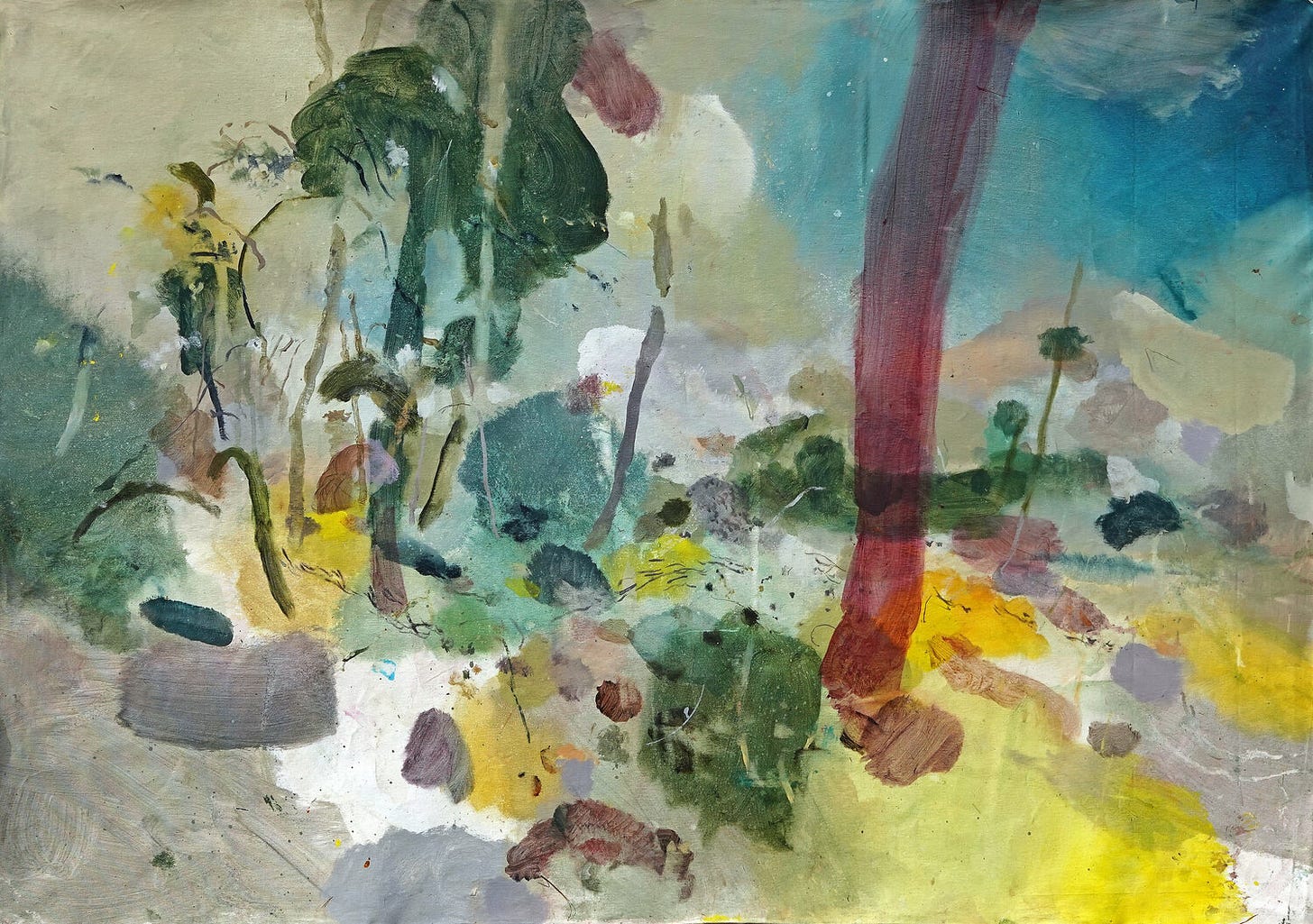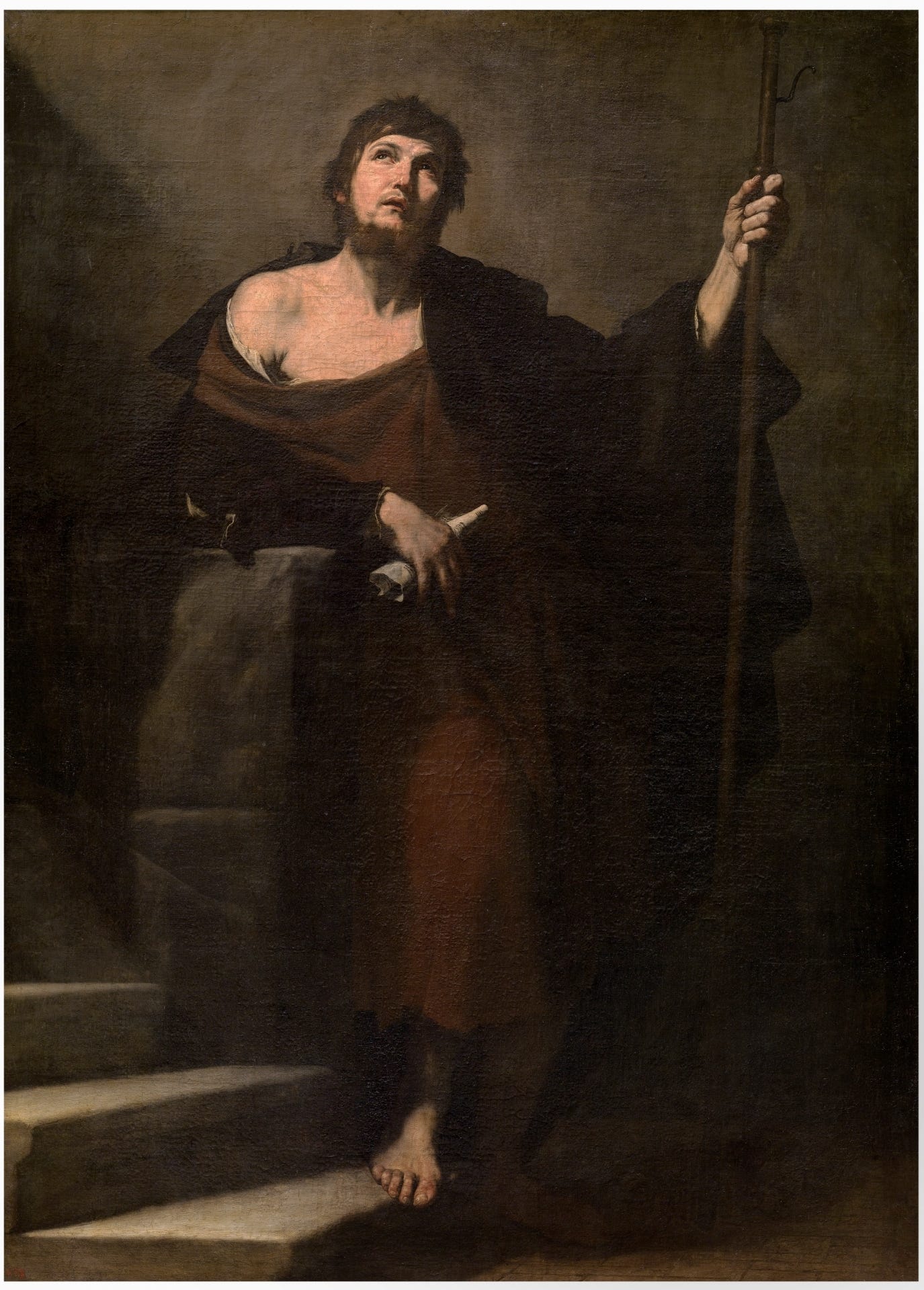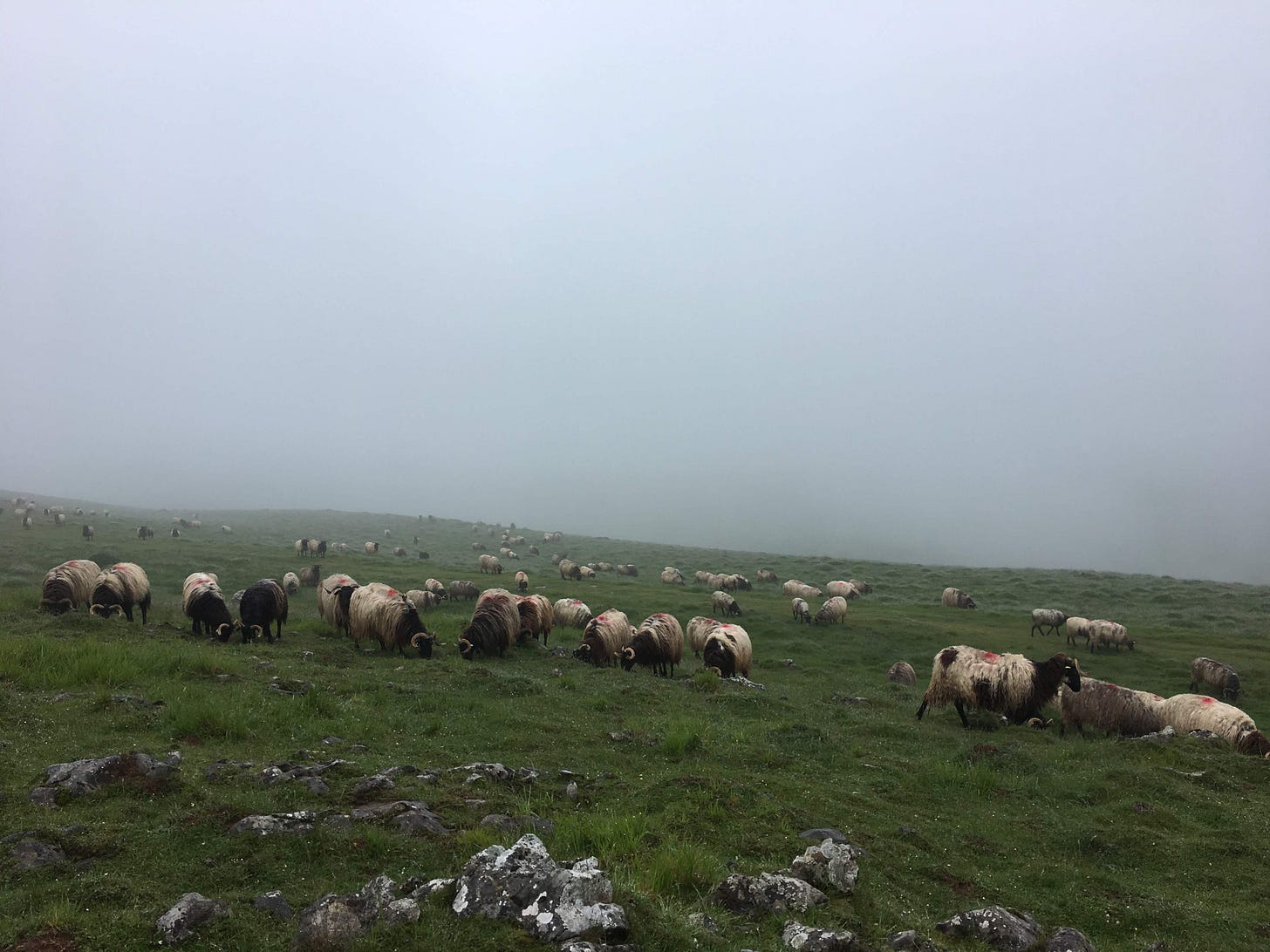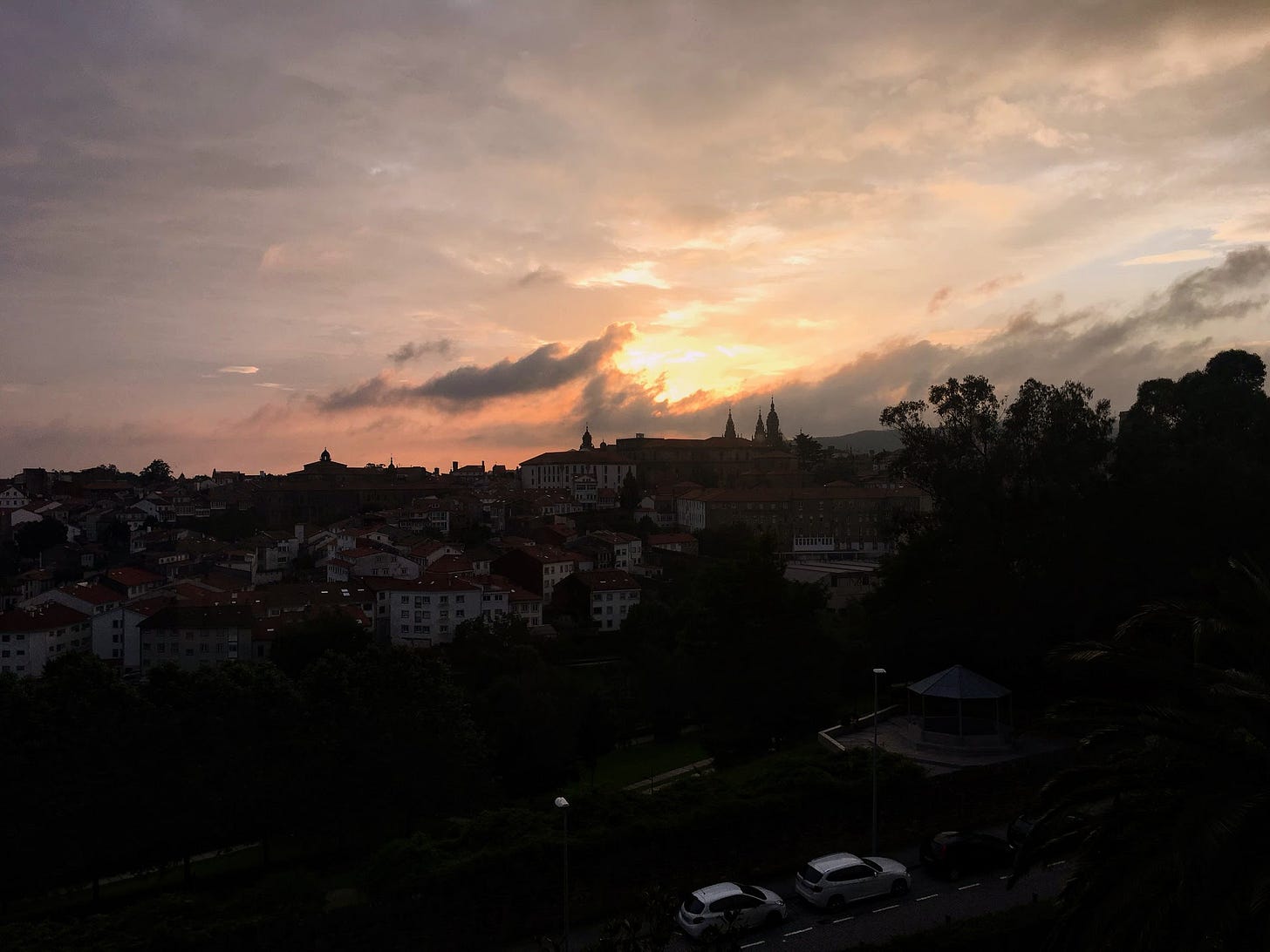Hello friends,
The month of June is quite dear to me for a number of reasons and always will be.1
In June 2018, Emily and I began walking the Camino de Santiago (a.k.a. the Way of St. James). Over the course of a month, we made the 500-mile pilgrimage from Saint-Jean-Pied-de-Port, a small Pyrenean village in southwestern France, to Santiago de Compostela in northwestern Spain.
Aside from what I’d gleaned in guidebooks before our trip, I knew little about the actual act of pilgrimage itself—what habits and attitudes a pilgrim should keep, what significance a pedestrian journey might hold, etc. Much less did I know anything of St. James himself. Still, the exhaustion and confusion of finishing my undergraduate degree a month earlier left me longing for clarity, a sense of direction, and fulfillment in something greater than myself. A pilgrimage—however inchoately conceived— seemed like a tried and true means of working this out.
We made the plans, bought the tickets, packed our bags as lightly as possible, and tore off. Surely we were dizzy with the thrill of it all.
Our first day was utterly miserable.
It began right away with a 15-mile hike out of Saint-Jean, ascending 4,000 feet through a series of switchbacks, followed by a steep 1,600-foot descent into the town of Roncesvalles.
Heavy clouds had settled over the mountain pass and dripped a slow rain all day. The path at every step was slick with mud. Three hours in, six more to go, and my legs were weak and trembling. The dull ache in my feet transformed, step by step, into a sleek blade of pain. Hunger accentuated my discomfort all the more.
I thought: Isn’t there supposed to be a bit of glamor to backpacking through Europe?
Something like anger began to sprout.
Nine hours later, the stone façade of the Roncesvalles Albergue emerged from the tree line.2 My brow, which I had wrinkled into tight knots, softened at once. My pursed lips parted, and I laughed.
I wanted to turn to Emily and shout We made it! Instead, some other sentiment bloomed: We will do the same thing tomorrow.
Something like defeat.
And for the next twenty-two days.
Something like acceptance.

Pilgrim, Tourist, Vagabond
So early on, acceptance could really mean no more than intellectual assent to an expected set of circumstances, not much different from, say, knowing that there is a sixty-percent chance of rain on Tuesday.
As we plodded on towards Santiago the task of acceptance grew increasingly more difficult. Sprained ankles, unbelievable blisters, little food, and even less sleep. Still, the thought of making it to our destination arrayed in bandages seemed to push us on all the more. Blessed are the meek, after all.
At other times, accepting the Camino’s trials became a more subtle duty to maintain.
To a hungry belly and tired eyes, what’s the harm in, say, stopping for pinxos or a quick cortado? All the better when I could rally up some fellow pilgrims to join me for a prowl about town.
Oh, to be a tourist—led hungry by my senses towards every pleasure oh-so-slight. Eating, drinking, merry-making, with no memento mori to wit.
On longer days, it was just as easy to dampen discomfort with a pair of earbuds and some music. To arrive at the next town, check into a hostel, have a light meal alone, and go to sleep. I could content myself, in this way, as a sort of vagabond—ambling from place to place, rootless and inattentive, priding myself in my utter independence from all that may have made demands of me.
Ultimately, though, the Way of the Tourist and the Way of the Vagabond are both, in equal measure, distractions from the Way of the Pilgrim. They sedate the spirit and dull the senses by means of the senses themselves, leaving the Pilgrim no more than a kind of snail—a fool with a too-large backpack. Follow either way long enough and my journey will converge upon a single sad end: the same hollow shell of myself I had when I began.
Attention’s Marriage
So distraction is the Pilgrim’s fiercest foe. In this regard, the Pilgrim is not all that different from the Poet we considered last month. He begins his journey, first and foremost, with an open eye kept vigilant.
But the Pilgrim has this other objective in mind, too: the sacred destination, the point of Divine encounter.

Without Attention, the Pilgrim’s journey will end as soon as he reaches his sacred destination.
But the Pilgrim, pure of heart, whose open eye is one with God’s, may see that “there are no unsacred places”.3 In this way, his journey ends and begins anew in a single stride.
Here, then, is Santiago and Rome and Bethlehem and the Western Wall, the Ka’abah and the Dome of the Rock. Here, the Ratha Yatri is about to begin. Here, Shakyamuni sits beneath every tree. Here, whatever veil lies between heaven and earth is but a thin gauze wearing thinner.
And yet the Pilgrim presses on. His destination all around, his journey incomplete.
Sustaining this awareness is absolutely vital.
Henry David Thoreau reflects from his time at Walden Pond in 1846: “We must learn to reawaken and keep ourselves awake, not by mechanical aids, but by an infinite expectation of the dawn…”.4
It’s the desire to stay awake, and the desire to learn how, that pushes the poet out the door and makes him a Pilgrim.
So while the Pilgrim goes in search of the sacred destination, Attention goes in search of its spouse—Action.
Continuing the passage from Walden above, Thoreau writes:
“It is something to be able to paint a particular picture, or to carve a statue, and so to make a few objects beautiful; but it is far more glorious to carve and paint the very atmosphere and medium through which we look, which morally we can do. To affect the quality of the day, that is the highest of arts.”
Thoreau spent a good deal of his time at his cabin by the pond meditating, writing, and fishing, living the deliberate life of the Poet. One day, on his way back to his cabin from Concord, this posture changed. A local constable had stopped him to collect his delinquent poll taxes.
“[Thoreau] declined, and [the constable] locked him up. The next morning a still-unidentified lady, perhaps his aunt… paid the tax. Thoreau reluctantly emerged, did an errand, and then went to collect huckleberries. A single night, he decided, was enough to make his point that he could not support a government that endorsed slavery and waged an imperialist war against Mexico.”5
Thoreau made his journey into the woods, paid attention, and found therein Repose—his eye one with God’s. I also may come to Walden Pond to sit, gaze, and rest a spell. But it is only a matter of time before my hands and feet, are one with Him, too. And then, they want only to make visible the Life-and-Peace-To-the-Full which God has revealed in Himself.
Attention envisions the world as God sees it. Action makes it concrete.
Attention spies the sacred in all things, however latent, and Action dredges it up.
Together they resist the solipsistic lure of tourism and vagabondry, seeing not only their cul-de-sac endings, but their subtle seeds of anger, fear, despair, and hate.
Thus in this marriage of Attention and Action, the Pilgrim at last reaches the point of Divine encounter. And in this union, he no longer acts as the griping, indulgent snail he has so often mistaken himself to be. Instead, dead to the subtle temptations of distraction, he sees himself truly and so acts truly—indeed he “acts in God’s eye what in God’s eye he is— / Christ…”.6
We Will Do the Same Thing Tomorrow
Our arrival in Santiago de Compostela at the end of June was not entirely unlike our arrival in Roncesvalles twenty-two days prior.
All the discomfort we learned so quickly on Day 1 magnified with each passing day. But on the floors of albergues we travelers gathered, bandaging our blisters and icing our knees. Around dinner tables, hospitaleros lavished us with cheap but hearty bread and wine. As conversations unraveled in spools, we made friends in unlikely places.
We will do the same thing tomorrow.
Something like joy.
Finally, at the sight of the St. James Cathedral, I cried. Tears again as inside the Botafumeiro swept across the altar and expelled its sweet smoke. It lingered thick over the Broken Body and the chalice of Blood.
And leaving there, the refrain again:
We will do the same thing tomorrow.
Only it would not be the same—it could not be. Having come through such trials, Attention and Action had finally met and the wedding was soon to be underway.
The new pilgrimage would soon unfold. The one back home, certainly—but also the one to home beyond home, the one unto Infinite Love. Which, of course, we’d never really left. Only He Who is Truly Sacred could deliver the wedding rites. For He Himself is Attention and Action and Love in their totality. The Way by Whom all weary walk, to Whom all laden labor, and to Whom all return.
Now, five years later, the refrain still rings.
Where to look
This month for me has been lighter on poetry and literature. I’ve instead been returning to an animated film by Hayao Miyazaki that I first saw when I was about ten years old, and a new album of country tunes from Iris DeMent. Both have been surprising, delightful companions.
Hayao Miyazaki’s Princess Mononoke (1997)
Hayao Miyazaki has imbued every frame of his 1997 film Princess Mononoke (Studio Ghibli) with the same spiritual potency that quickens the Pilgrim we’ve considered this month.

Here, Miyazaki traces the story of Ashitaka, the last living prince of a waning indigenous people of Japan’s Tohoku region. After a demon ravages his village and infects him with its hateful poison, Ashitaka takes up a journey to meet with the Great Forest Spirit in the woods to the west, searching for healing and “to see with eyes unclouded by hate.”
Arriving at those woods, he finds them likewise ravaged. Not by demons, but by a precariously expanding iron refinery and the looming threat of war. Ashitaka, then, finds himself in a struggle for his own healing and for the healing of his land of exile.
It’s well known that Miyazaki is a master of animated storytelling, but after watching this film for the first time in seventeen years a few weeks ago, I am convinced that he is one of our world’s very best spiritual teachers, as well. His morally complex characters allow for the emergence of much more than dualistic fables of good-versus-evil, or for the egocentric self-actualizations that have become trademarks of Western story. So what Miyazaki leave us with in Princess Mononoke is a rich understanding of the life of the Pilgrim who wants only to Love and to be Love.
Iris DeMent’s Workin’ On A World (2023)
Iris DeMent’s newest album Workin’ on a World (Flariella Records, 2023) is populated with pilgrims going about the ora et labora of life in this world, each of them working towards a common goal: the Life of the World to Come. She sings in the title’s opening track as horns burst around her,
Now I’m workin’ on a world I may never see, Joinin’ forces with the warriors of love Who came before and will follow you and me.
From there, DeMent introduces us to those “warriors of love”—ordinary and legendary alike. The legends are perhaps not so surprising: Martin Luther King Jr., John Lewis, Rachel Corrie, Mahalia Jackson, Christ Himself. Still, DeMent is never trite. How could she be when she looks to their examples in such earnest?
DeMent is no less earnest in drawing from her ordinary warriors either—a cast of characters ranging the person who can “say a good word” to “friends [who] now wear an enemy’s face”; families struggling to make ends meet; an anonymous man from Waycross, Georgia, his eyes full of “joy and pain” as he is “just going home”.
The songwriting on this record is about as lucid as you could want. Relying on the tried and true conventions of all great American folk music (think the political candor of Baez and Guthrie, with the more quotidian sensibilities of Harris and Prine), DeMent’s songs here unabashedly pronounce good news and bad to those who need to hear it most, sometimes in the span of just a single song, thus verging on the kerygmatic.
Miscellany
In this new section of The Kingfisher Chronicle, I’ll collect odds and ends that I’ve found enriching and relevant, but which for the sake of length I’ve chosen not to elaborate on. Items here will be listed like this:
Poet and teacher Sri Chinmoy joins “The Pilgrims of the Lord Supreme” in becoming “the drops and flames/of Transformation Light.”
Peace advocate Andrew DeCort turns to Thomas Merton and the Lord’s Prayer to search out “Seeds of Contemplation and Revolution Amid War” (Comment) in Ethiopia.
Also in Ethiopia, the Orthodox Church partners with ecologists to conserve local biodiversity through “church forests” (Emergence Magazine).
Modern-day mountain hermit Tim Bunting weighs the merits of Shugendō pilgrimage and Stoic philosophy (Psyche).7
Belt Magazine editor-in-chief Sam Dresser calls for “A New Paganism” (Aeon).
Art historian Matthew Milliner considers how “The Wisdom Hypothesis” (The Hedgehog Review) of Sofiology might inform conversations of eco-spirituality.
Michael Martin of
examines “The Vanishing of the Faeries” from industrialized society.
Friends, I love art that stimulates the mind and heart, but remember: a Pilgrim needs very little. I hope you’ll find the time to explore the above pieces, but more so do I hope you’ll find this month renewed attention and vitality for whatever journey you’re on.
Gratefully yours,
Connor
(Happy almost-anniversary, Emily!)
Albergue translates from Spanish to mean something like to “hostel” in English. Hostel in Spanish, however, bears the connotation of a boutique inn, more akin to the American bed-and-breakfast. Therefore, the term albergue, along the Camino’s many routes, is used almost exclusively in reference to pilgrim boarding.
Berry, W. (2001, January). How To Be a Poet. Poetry Magazine. https://www.poetryfoundation.org/poetrymagazine/poems/41087/how-to-be-a-poet
Thoreau, H. D. (1995). Walden: Or, Life In the Woods. Dover Publications. (Original work published 1854).
Britannica. Editors of Encyclopaedia (2023, May 2). Henry David Thoreau. Encyclopedia Britannica. https://www.britannica.com/biography/Henry-David-Thoreau.
Hopkins, G. M. (1985). As kingfishers catch fire. In Poems And Prose. Penguin Classics. (Original work published 1918)
I’m obliged to thank
for recommending this piece and the following one through his Substack, .






I really enjoyed this. Very thought provoking! Thanks for sharing 💕
Mr. Brown! This is hands down my favorite KFC publication to date. I loved reading your reflections on walking the Camino, painting a picture of our spiritual journey as pilgrims. Thinking back to all the memories you shared on that walk was a delight.
In my reflection I came across a poem and a haiku that resonated with your experience. Just thought I would share:
In Spain's humble land, a path unfolds,
The Camino of Santiago, where true beauty molds.
A pilgrimage embraced, devoid of glamour's sheen,
Yet the sacred destination holds the ultimate scene.
Like simple Pinxos, unassuming at first glance,
The Camino's essence lies in its sacred dance.
Amidst the challenges, where weariness may reign,
The soul finds solace in the destination's domain.
Through rugged valleys and arduous terrain,
The spirit perseveres, fueled by a purpose unfeigned.
Mountains rise resolute, with a steadfast might,
Guiding pilgrims onward, through day and night.
The Camino, a tapestry of human connection,
Where self-discovery blooms with profound affection.
Like modest Pinxos, unpretentious and plain,
People converge, their spirits intertwined in refrain.
A humble cortado, a momentary pause,
The Camino provides respite, an invaluable cause.
Amidst the toil, moments of profound grace,
Where weary hearts find solace in sacred space.
Each blistered footstep whispers tales untold,
A testament to the fortitude of the bold.
Just as Pinxos delight beyond their humble guise,
The Camino's true essence lies in the sacred prize.
So lace your boots, embrace the path with might,
For the Camino unveils its treasures out of sight.
Where the sacred destination becomes your sacred shrine,
Embrace the challenges, for they lead to the divine.
***
Lastly a Haiku:
Camino unfolds,
Sacred destination waits,
Blistered soles find peace.
***
Thanks for sharing your heart with us Mr. Brown! Much love!